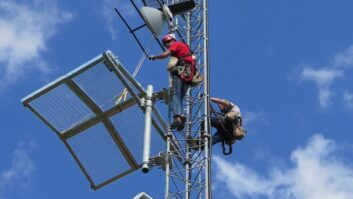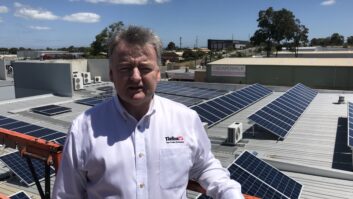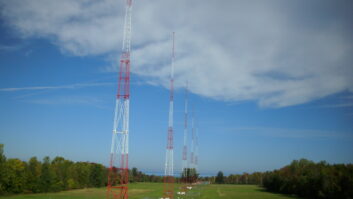Changes in tower standards
Mar 1, 2004 12:00 PM, By Kevin McNamara, CNE
Sometime this year the Telecommunications Industries Association (TIA) will release the most comprehensive revision to the tower standards since 1996. The standard currently known as EIA/TIA-222-F defines the industry accepted practices and minimum standards for the design of steel antenna supporting structures.
History
The EIA RS-222 standard was first published in 1949 and encountered only two updates until 1980, when the 222C version was published. This was an important document because it took into account more of the real-world knowledge acquired as the deployment of so-called tall towers (up to 2,000 feet) were becoming widespread and the effects of wind and icing were becoming apparent. Not only were these towers taller, but they supported significantly more weight, particularly with antennas used for TV.
Version C provided a perspective for rating wind load based on the height of the tower and where it was located. A map of the United States was delineated into three wind zone categories labeled A, B and C. The wind loading was considered over the full length of the structure and was measured in pounds per square foot (PSF). The specific PSF rating started at about 30 PSF and increased based on the tower height.
The 222-D specification made a dramatic change to the way wind loading was to be calculated. First, the wind speed was measured in miles per hour (MPH) and a new map was created that depicted basic wind speeds measured at 33 feet above the ground. The value for basic wind speed increased as a function of tower height.
Revision E was the first iteration of the code to be defined by the TIA and Electronics Industries Association (EIA) and thusly called EIA/TIA 222-E. It further created a wind-loading map based on specific counties within each state, as well as directing the engineer to consider and design for specific conditions that might exceed the standard values.
The current version of the code, called EIA/TIA 222-F, was adopted in 1996 and expanded the scope of the previous version to include the effects of ice loading. Basically, it provided two methods for analysis of ice. Both assume an accumulation of ice based on that specified by the engineer; however, the wind load applied to the tower could be analyzed at full-speed or at about 75 percent of the full assumed speed.
Enter EIA/TIA-222-G
The differences are significant in revision G and will most likely affect tower owners who want to make additions to existing structures or those building new towers.
The philosophy behind the new revision is based on two design limit states � strength and serviceability. The strength limit considers the loading of a tower under extreme conditions; the serviceability limit ensures the tower will provide the proper service under normal conditions.
Towers are also analyzed under four specific types of loading: wind, environmental, ice and seismic.
The effects of wind on a tower are no longer based on a single wind zone chart, but rather a number of external conditions that might change the dynamic of wind, such as terrain, gusts, the method that wind-speed is determined and the value of safety factors used for a specific tower type.
An interesting feature of the new standard is the inclusion of s-called environmental loads. While the underlying thinking for this feature directs the designer to apply wind-loading characteristics based on mean wind speeds averaged over 25, 50 or 100-year periods, it requires that the tower be classified into one of three categories. The categories, labeled I, II or III, define the impact a failure of the tower would have to operational integrity, human life and property then apply a proportionate amount of over design.
Ice loads assume the ice has formed completely around a steel member and is assumed to be twice the maximum projected thickness of the radial ice. To assess the potential for icing a fixed factor for temperature drop is assumed, typically 508F ice loads are increased as a function of tower height.
The final load criteria, seismic, is also a new consideration within the 222G standard. Generally, this will only be considered within certain seismically active areas.
222G and local building codes
For the first time, the EIA/TIA-222-G code will line-up with national building codes, most notably the 2002 version of the International Building Code (IBC). If you haven’t seen a copy of this code, it outlines all of the possible code-related items and refers the reader to several references of other codes, such as NEC and NFPA. The underlying reference to which the IBC deals with telecommunications towers is called ASCE-7. ASCE is an acronym for the American Society of Civil Engineers and ASCE-7 deals with all things structural, including towers. The latest version of ACSE-7 (2002) will ultimately refer you to what will be the EIA/TIA-222-G standard.
If you have recently constructed a tower in a state or local jurisdiction that has adopted the code, you may have been asked to provide a structural showing compliance with a specific version of the IBC. Note that the previous version of the IBC (2000) references the EIA/TIA-222-F version.
Free tower upgrade?
With the proliferation of wireless services throughout the country, several broadcasters are benefiting from additional rental opportunities from the wireless carriers. In some cases, your tower may be at its structural maximum load limit, particularly under the new standards. But did you know you might be able to get a free upgrade?
If you have been approached from a site acquisition contractor (SAC) working for one of the carriers, but you don’t have the structural capacity to accommodate another set of antennas, suggest to the SAC that you will be interested, but the carrier will need to assume the costs of a new structural analysis and upgrade drawings, as well as the labor and materials for the upgrade. The carrier may be willing to take on those costs because the time and associated costs to get zoning approval on an existing tower may be much cheaper than trying to zone for a new structure. Also, the costs to develop a new site are typically much higher.
Of course, the carrier will expect little or no rental payment for a fixed period of time and possibly some form of co-development recovery, should another carrier lease space on the carrier.
McNamara is president of Applied Wireless, Elkins Park, PA.






